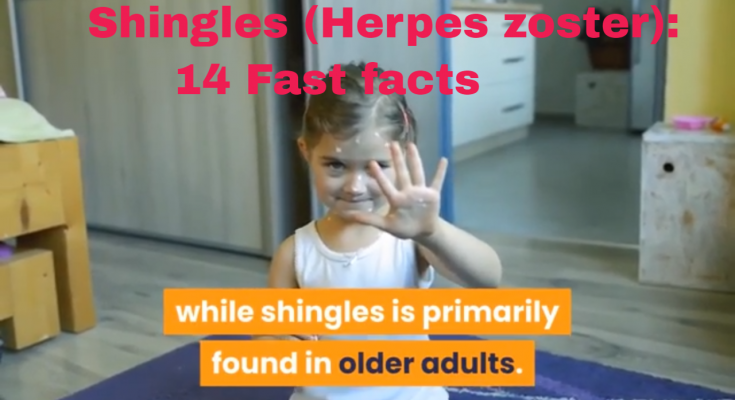Updated: April 2, 2024
14 Fast facts
- Shingles is a viral infection.
Shingles is also referred to as herpes zoster or varicella zoster. - The chicken pox virus causes shingles.
Shingles is caused by the varicella zoster (herpes zoster) virus, the same virus that causes chicken pox. - People age 50 and older are more likely to get shingles.
Although it is possible for anyone to get shingles, older adults are much more susceptible, due to increased potential for weakened immune systems.
In fact, anyone with a weakened immune system (i.e. individuals with AIDS, those going through cancer treatments, etc.) has a higher probability of getting shingles. - Shingles is contagious (although uncommon).
If you have never had chicken pox (or the chicken pox vaccine), skin to skin contact with another person’s shingles rash can cause you to develop chicken pox. - There is an effective shingles vaccination.
Like other vaccinations, the shingles vaccination cannot be considered 100% effective.
Regardless, the shingles vaccination will significantly decrease a person’s chances of getting the shingles virus. - Shingles is common.
Every year, approximately one million Americans get shingles.
Research indicates there is a 1 in 4 chance you will develop shingles at some point in your lifetime.
Important to keep in mind is that older adults and those with a weakened immune system are far more likely to develop shingles. - Shingles usually lasts 2-4 weeks.
The rash symptoms associated with the shingles virus typically take anywhere from 2-4 weeks to heal.
Typically, the rash turns into blisters, which eventually pop, and ultimately, heal within a month.
- Shingles is not the same as chicken pox.
Beyond the fact that shingles and chicken pox share the same disease-causing agent (the varicella zoster virus), they are quite different.
Chicken pox typically affects children, while shingles is primarily found in older adults. - You can get shingles more than once.
Although fairly uncommon, some people suffer from more than one episode of shingles. - A rash is the most common symptom of shingles.
The rash is usually a cluster of red, painful blisters that itch.
Typically, the rash appears on just one side of the body. - It is important to steer clear of scratching.
For the blisters and rash associated with the shingles virus to heal as quickly as possible,
it is important to not scratch the affected area.
Also, scarring can be prevented if scratching is avoided. - There are other symptoms associated with the shingles virus.
Headache, fever, rash, and painful blisters are all the symptoms of shingles. - Undergoing cancer treatment.
Radiation and chemotherapy can lower the body’s resistance to disease and infection,
and ultimately trigger shingles - Taking some medications.
Particularly medication prescribed after an organ transplant.
Also, extended time on steroids is involved.
Disclaimer:
All the material is provided for educational and informational purposes only.
No responsibility can be taken for any results or outcomes resulting from the use of this material.
While every attempt has been made to provide information that is both accurate and effective,
the author does not assume any responsibility for the accuracy or use/misuse of this information.
Keywords: herpes zoster, shingles, herpes, zoster, pain, cures, natural cures, health, natural health, natural remedies, natural therapies, natural health cures, holistic natural cures





